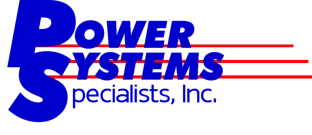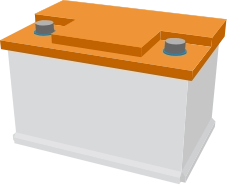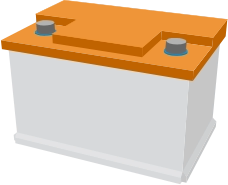

Copyright © Power Systems Specialists, Inc.
Send e-mail to: webmaster@p-s-s.com with questions or comments about site

Sealed Lead Acid Battery
A VRLA (Valve Regulated Lead Acid) Battery is a sealed style of battery. Every manufacturer has their own way of building a battery and they try to design the battery to provide the most power in the smallest footprint.VRLA Design:
The battery jar has internal multiple plates made up of both positive and negative plates. These plates are designed with lead and alloys and have a separator mat between the positive and negative plates to prevent shorting out of the plates. The separator mat is a special mat that has the sulfuric acid solution absorbed into the mat. This prevents the electrolyte from being able to be spilled and keeps the battery from gassing like a Wet Cell Battery does. The manufacturer designs the battery case with seals and special wields to prevent leakage of the battery. In the battery case there is a special valve regulator that will allow venting of the jar should it develop internal pressure due to a failure for safety purposes. Due to the nature of the design of Sealed Lead Acid Batteries, they do not off gas so they do not require special ventilation and can be installed directly on Data room floors and office spaces.Application:
The Sealed Lead Acid Battery has to perform differently in a UPS application versus a DC Power Plant application. Because of this, the sizing of the battery becomes very important. For UPS installations, a Sealed Lead Acid Battery has to maintain a constant voltage to the UPS so the current draw from the battery will actually increase over the discharge time. For DC Power Plants during the battery discharge, the Sealed Lead Acid Battery is designed to supply a constant current over the discharge time and the DC voltage will drops. Typically for UPS applications, the battery system is designed to only supply backup power for a short time. In DC Power Plant applications, the battery system is typically designed to give backup power for long periods of time. As an example, it is not uncommon for DC Power Plants to provide backup for up to 8 hours while UPS systems may only be designed to run 15 minutes.Cost Savings:
Because of the design of a Sealed Lead Acid Battery, these batteries require less maintenance than Wet Cell battery systems. As a minimum, a Wet Cell Battery system should have maintenance performed quarterly, where as a Sealed Lead Acid Battery system is every 6 months. VRLA batteries have a sealed design so they do not require makeup water to be added to the individual cells. This can save a lot of manpower cost required for maintenance. However, site personnel should still inspect the battery system monthly to make sure that the batteries do not show any signs of overcharging or any other type of damage to the jar. The big advantages of a Sealed Lead Acid Battery system is that the batteries are much cheaper than a Wet Cell system. However, a VRLA battery does not have the same design life that a Wet Cell Battery has. Depending on the type of Sealed Lead Acid Battery they can have a design life of 5 years, 7 years, 10 years, and other specialty ones greater than 10 years. The design life does mean that in a real world application that the battery will last the full design life period with discharges. Depending on how many discharges and the duration of the discharge that occur, this will determine the actual life of a Sealed Lead Acid Battery. Sites with large amounts of battery discharges can have the battery life shorten a large amount due to the amount of discharges. Typically a Sealed Lead Acid Battery system that has a 5 year rated design will typically be replaced in 3-4 years. A 7 year rated battery will be replaced around 5 years. The 10 year rated battery will usually last 7 or more years. Some Sealed Lead Acid Batteries for DC Power Plants will have a design life in excess of 10 years and they will vary on the actual life of the battery. All of this is based on proper maintenance provided on the battery and the battery is in a good environment and not exposed to larger amounts of discharges. So with the Sealed Lead Acid batteries being cheaper than a Wet Cell Battery, they will be required to be replaced more often than a Wet Cell battery.Space Saving Design:
An additional advantage of a Sealed Lead Acid Battery is that they can be installed in cabinets and take up less space than a Wet Cell Battery system would normally require. Due to the nature of the VRLA battery design, the batteries can be installed in more areas in a facility and they require less maintenance thereby saving the facility more in the cost of a battery system.Recyclable:
Sealed Lead Acid Batteries are almost totally recyclable, averaging around 98% of the total battery is recycled. By federal and State laws, all batteries including a Sealed Lead Acid Battery, must be sent back to a lead recycling plant to have all the materials reclaimed, they can not be sent to landfill.
Call Toll Free (888) 305-1555


Design Life
(What is it)
With the battery on float charge over the course of its life, without any discharges, then the battery would still be able to put out its rated power at the end of its design life. Every discharge takes a little bit of the battery life away and over time these discharges will shorten the actual life of the battery.



Sealed Lead
Acid Battery
A VRLA (Valve Regulated Lead Acid) Battery is a sealed style of battery. Every manufacturer has their own way of building a battery and they try to design the battery to provide the most power in the smallest footprint.VRLA Design:
The battery jar has internal multiple plates made up of both positive and negative plates. These plates are designed with lead and alloys and have a separator mat between the positive and negative plates to prevent shorting out of the plates. The separator mat is a special mat that has the sulfuric acid solution absorbed into the mat. This prevents the electrolyte from being able to be spilled and keeps the battery from gassing like a Wet Cell Battery does. The manufacturer designs the battery case with seals and special wields to prevent leakage of the battery. In the battery case there is a special valve regulator that will allow venting of the jar should it develop internal pressure due to a failure for safety purposes. Due to the nature of the design of Sealed Lead Acid Batteries, they do not off gas so they do not require special ventilation and can be installed directly on Data room floors and office spaces.Application:
The Sealed Lead Acid Battery has to perform differently in a UPS application versus a DC Power Plant application. Because of this, the sizing of the battery becomes very important. For UPS installations, a Sealed Lead Acid Battery has to maintain a constant voltage to the UPS so the current draw from the battery will actually increase over the discharge time. For DC Power Plants during the battery discharge, the Sealed Lead Acid Battery is designed to supply a constant current over the discharge time and the DC voltage will drops. Typically for UPS applications, the battery system is designed to only supply backup power for a short time. In DC Power Plant applications, the battery system is typically designed to give backup power for long periods of time. As an example, it is not uncommon for DC Power Plants to provide backup for up to 8 hours while UPS systems may only be designed to run 15 minutes.Cost Savings:
Because of the design of a Sealed Lead Acid Battery, these batteries require less maintenance than Wet Cell battery systems. As a minimum, a Wet Cell Battery system should have maintenance performed quarterly, where as a Sealed Lead Acid Battery system is every 6 months. VRLA batteries have a sealed design so they do not require makeup water to be added to the individual cells. This can save a lot of manpower cost required for maintenance. However, site personnel should still inspect the battery system monthly to make sure that the batteries do not show any signs of overcharging or any other type of damage to the jar. The big advantages of a Sealed Lead Acid Battery system is that the batteries are much cheaper than a Wet Cell system. However, a VRLA battery does not have the same design life that a Wet Cell Battery has. Depending on the type of Sealed Lead Acid Battery they can have a design life of 5 years, 7 years, 10 years, and other specialty ones greater than 10 years. The design life does mean that in a real world application that the battery will last the full design life period with discharges. Depending on how many discharges and the duration of the discharge that occur, this will determine the actual life of a Sealed Lead Acid Battery. Sites with large amounts of battery discharges can have the battery life shorten a large amount due to the amount of discharges. Typically a Sealed Lead Acid Battery system that has a 5 year rated design will typically be replaced in 3-4 years. A 7 year rated battery will be replaced around 5 years. The 10 year rated battery will usually last 7 or more years. Some Sealed Lead Acid Batteries for DC Power Plants will have a design life in excess of 10 years and they will vary on the actual life of the battery. All of this is based on proper maintenance provided on the battery and the battery is in a good environment and not exposed to larger amounts of discharges. So with the Sealed Lead Acid batteries being cheaper than a Wet Cell Battery, they will be required to be replaced more often than a Wet Cell battery.Space Saving Design:
An additional advantage of a Sealed Lead Acid Battery is that they can be installed in cabinets and take up less space than a Wet Cell Battery system would normally require. Due to the nature of the VRLA battery design, the batteries can be installed in more areas in a facility and they require less maintenance thereby saving the facility more in the cost of a battery system.Recyclable:
Sealed Lead Acid Batteries are almost totally recyclable, averaging around 98% of the total battery is recycled. By federal and State laws, all batteries including a Sealed Lead Acid Battery, must be sent back to a lead recycling plant to have all the materials reclaimed, they can not be sent to landfill.


Copyright © 2002-2011 Power Systems Specialists, Inc
Send e-mail to: webmaster@p-s-s.com with questions
or comments about site
Call Toll Free (888) 305-1555





























